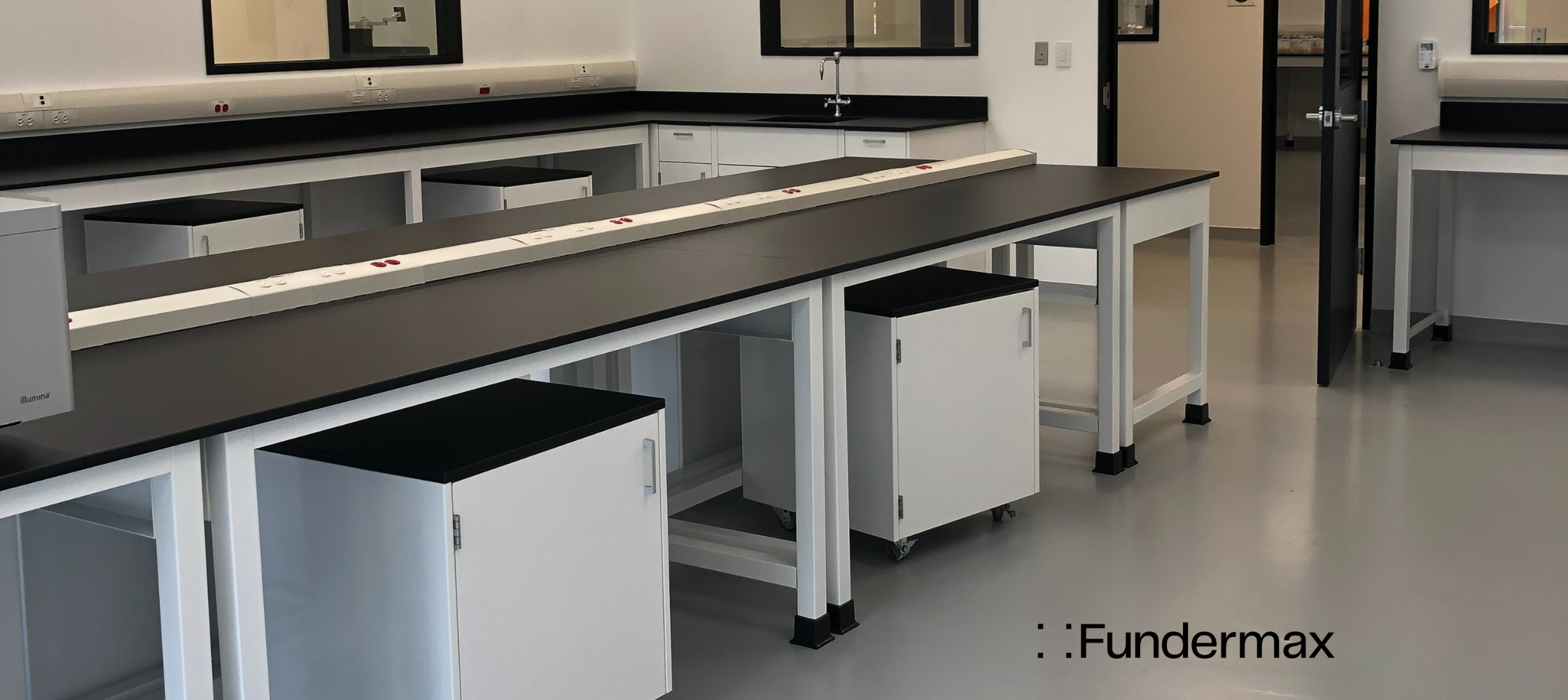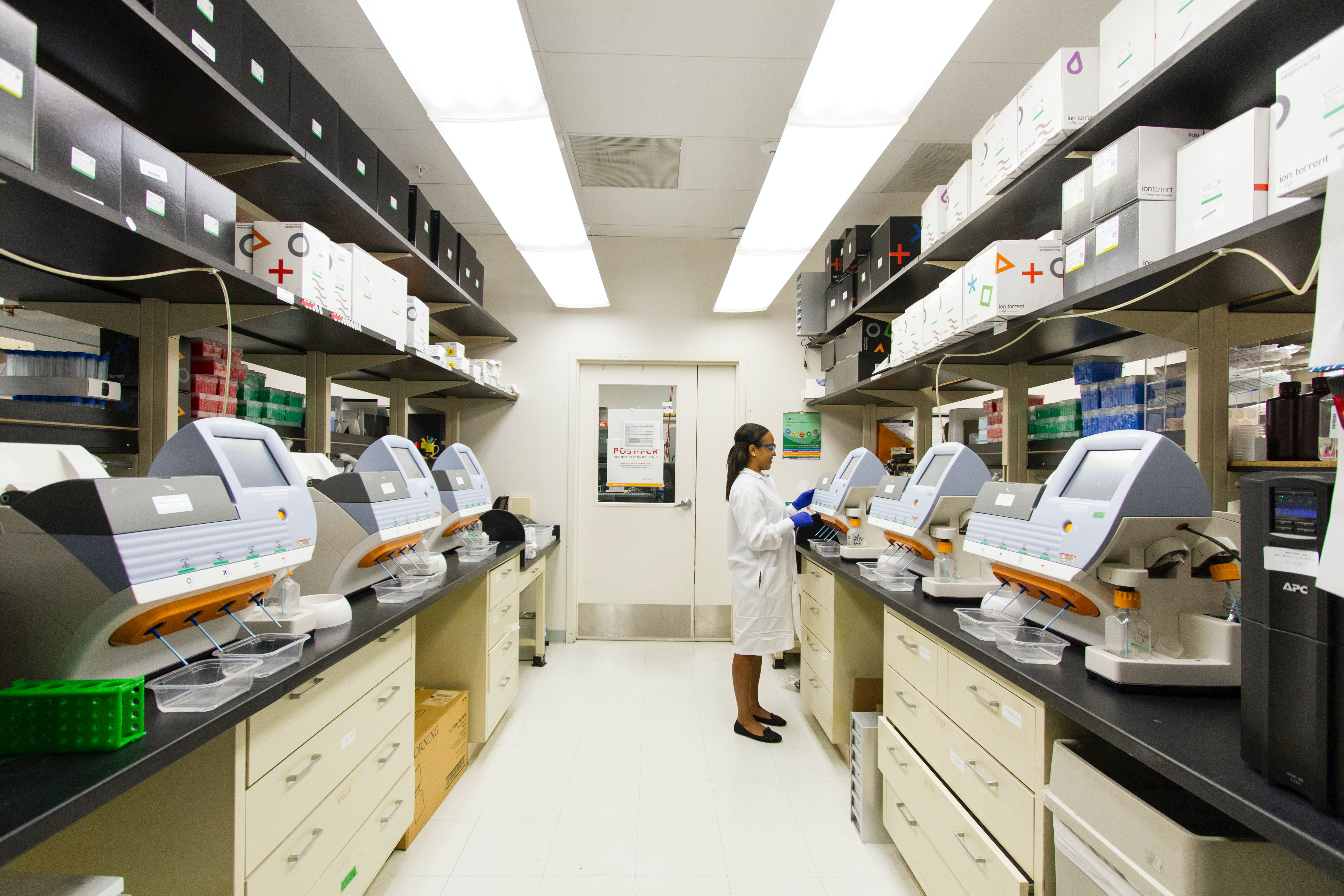
Maintaining and Cleaning Phenolic Lab Work Surfaces & Casework
| Last updated August 26, 2025
Anyone who has worked in a lab knows: If there is a spill, you must clean it immediately – and what you clean it with will depend on what was spilled. So, if you’re looking for specific spill-cleaning guidelines, please refer to these resources:
Meanwhile, this blog post will focus on general housekeeping and upkeep of your lab work surface; and specifically, we will discuss Fundermax Max Resistance2 phenolic work surfaces.
Fundermax is a phenolic panel manufacturer known globally for exterior, interior, and laboratory applications. Our durable high-pressure laminate (HPL) panels are used in commercial and residential buildings, labs, university buildings, public facilities, and more.
Fundermax Max Resistance2 is our lab-grade phenolic material, so we can advise with certainty about what is appropriate for these work surfaces compared to others. (If you’re working with phenolics from a different manufacturer, remember to check even basic housekeeping recommendations with them directly.)
Importance of Cleaning Lab Work Surfaces
Considering the busy nature of the lab environment, most lab employees can appreciate the importance of establishing cleaning and disinfection protocols in order to reduce any number of hazards. As such, much of what we share here will be information that is already well-established in your laboratory. Our hope is to affirm these best practices as a common foundation from which labs can then move into greater specifics depending on their particular lab work surfaces, types of lab spills, and approved cleaning agents.
Physical Environment
Since each lab environment can vary widely, it’s essential that the lab director conduct an audit of the department’s physical environment to identify any particular hazards that need to be addressed during regular housekeeping. Sometimes the placement or movement of equipment impacts housekeeping and overall lab cleanability. Particularly, the advent of AI and more computer connectivity demand a greater mindfulness of wires and increased consideration of what can be moved and cleaned.
Additionally, any lab technician can agree that the sheer number of items out on an open bench at any given time warrants regular tidying! Bottom line: move what you can, and clean as often as makes sense for your environment. Here, we again want to affirm what you already know to be true: keeping a clean work surface matters, especially when it can affect the results of your work, so establish and uphold general lab cleaning practices that work for your lab.
Frequency
As a matter of general housekeeping, some labs wipe down their laboratory work surfaces as many as 3 to 4 times a day or more; some, just once a day. It’s essential to identify what frequency is optimal for your lab environment.
For general housekeeping, when cleaning lab work surfaces, first wipe down all areas with just water (or soap and water) in order to clear any spilled materials or visible soils before applying disinfectant. This helps to ensure there are no reactions.
Refer to the EPA, CDC, OSHA, and your respective EHS department for guidance in choosing the right disinfectants. Use only approved cleaning products, and use the correct PPE even during normal housekeeping. Additionally, always contact the manufacturer of your specific work surface and obtain their recommended cleaning processes to ensure you don’t compromise the work surface in the course of regular cleaning.
General Spill Cleanup
Liquid Spill
These likely go without saying, but for the sake of thoroughness, note the following imperatives in case of any liquid spill:
-
identify what was spilled
-
identify the approved cleaning agent
-
use the proper PPE
-
clean up immediately.
In practice, first clean the spill using water or soap and water; then clean with a germicidal wipe, bleach, or other relevant cleaner. Note that when you use a bleach product, it’s important to follow up, distilled water, or water. Allowing bleach residue to build up after cleaning can harm even the most durable lab work surfaces.
Particle Spill
Particle spills can present their own hazard to laboratory work surfaces if not properly addressed. It’s of course important to clean up all lab spills, but it’s particularly important to clean up particle spills before putting anything heavy on the lab work surface; otherwise, the particles may scratch or otherwise damage the work surface.

General Lab Cleaning & Disinfecting
As we mentioned earlier, some labs wipe down their laboratory work surfaces many times each day. Those specifics will depend on your lab, but as a general rule for lab surface maintenance, clean at least once a day (and between shifts) with soap and water, germicidal wipes, or a disinfectant spray. Note that even dry labs should have regular cleaning protocols, even as simple as soap and water once a day.
Visual Inspection
Before wiping down any lab work surface, always check for sharps. This is of course for your own safety, but an errant sharp can also gouge and damage even scratch-resistant lab work surfaces.
Also when cleaning, check for areas that are prone to collect bacteria including scratches or pitting on the surface, seams in the work bench, and seals around sinks (more on this below).
Cleaning Sink Areas
Make sure to regularly clean sink areas. Chlorine in the tap water can damage some work surfaces. Note that chlorine does not affect Max Resistance2, but that is not the case for most other materials, so it’s important to establish this as a regular housekeeping practice.
For both undermount sinks and drop-in sinks, remember to check the seal. The seal is often overlooked, and it’s an easy place for dirt and bacteria buildup.
Cleaning Lab Casework
When cleaning the work surface and casework, remember to clean the edge and under the drip groove. Drip grooves are a common housekeeping oversight, so this is a good reminder to include in your daily cleaning checklist for your staff.
A Note About Disinfectant Wipes
Disinfectant or germicidal wipes are allowed and commonly used in the laboratory environment. However, as a sustainable company, we’d be remiss to not point out that germicidal wipes - although convenient - are not a very eco-friendly option. We encourage you to find more sustainable solutions for your regular housekeeping needs; perhaps even simply spraying and wiping the surface disinfectant with a clean microfiber cloth that can be washed and reused.
Things to Avoid
No matter the type of work surface or lab spill, do not use any type of physically abrasive cleaning method, such as a scouring brush or steel wool. As you know, scratch-resistant work surfaces are essential to the lab environment to avoid the buildup of chemicals, microorganisms, and bacteria. However, physically abrasive cleaning methods can potentially damage even the most scratch-resistant materials. If a work surface becomes damaged or compromised, consider work surface replacement or using a cover in that area to avoid the risk of bacteria growth.
Recommendations: Recap
-
Compile a basic Cleaning 101 Checklist that is tailored to your particular lab environment and is readily available to all lab workers.
-
Be sure to use cleaning products that are approved for your type of spill, work surfaces, and lab. Please refer to the EPA, CDC, OSHA, and your respective EHS department.
-
Consult with the manufacturer of your specific material for instructions. For specifics on cleaning Max Resistance2 work surfaces, click here to download our ready-made cleaning document.
-
Don’t allow cleaning product residue to build up. Always follow up cleaning with 70% ethanol, distilled water, or water.
-
Never use physically abrasive cleaning methods. Always check for sharps.
-
Always use proper PPE.
-
Dispose of cleaning wipes carefully; make plans for the responsible disposal of potentially hazardous cleaning waste.
In addition to EHS compliance and general lab safety, regularly cleaning lab work surfaces will help maximize their longevity. With a quality material and proper upkeep, your phenolic work surfaces can look the same in year 10, 20, or 30, as they did on installation day.
If you’d like to discuss solutions for your laboratory, or for more information on Max Resistance2 phenolic lab panels, contact Fundermax today.

